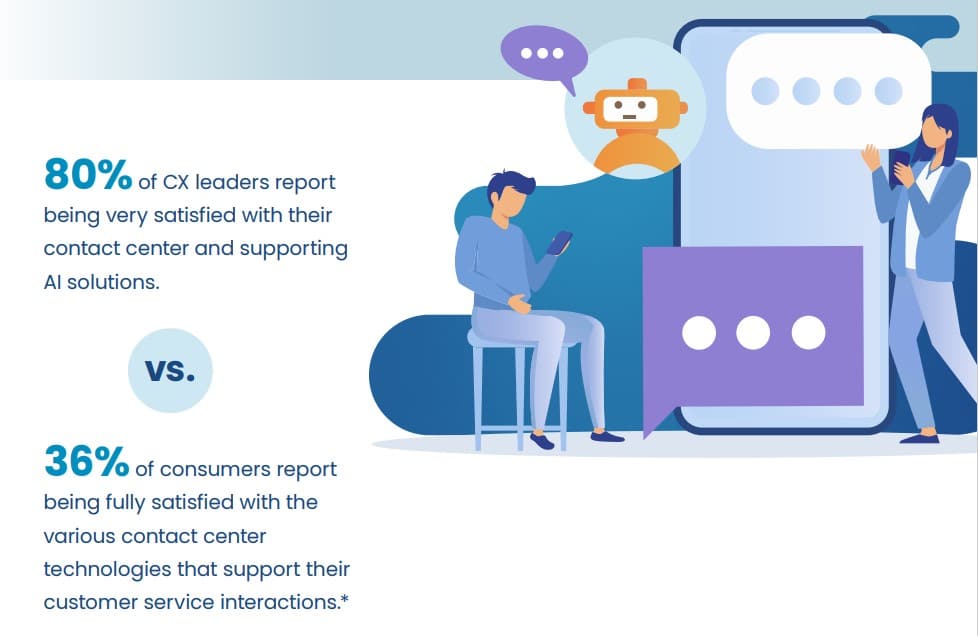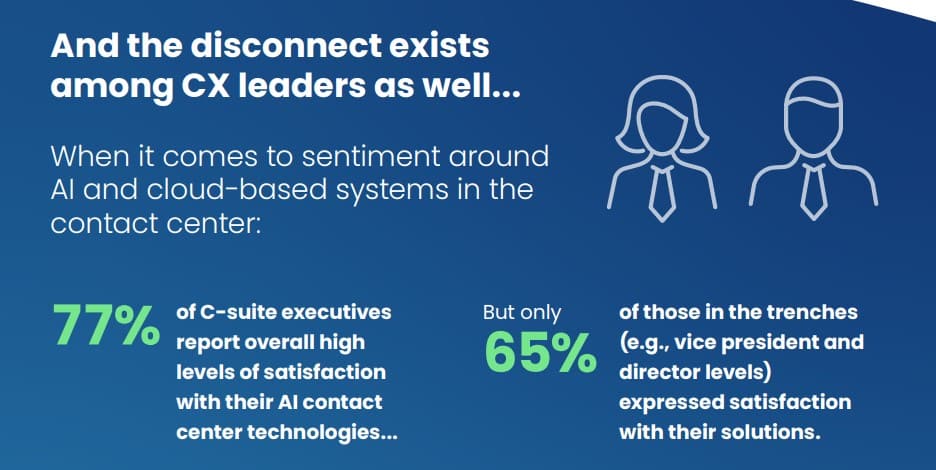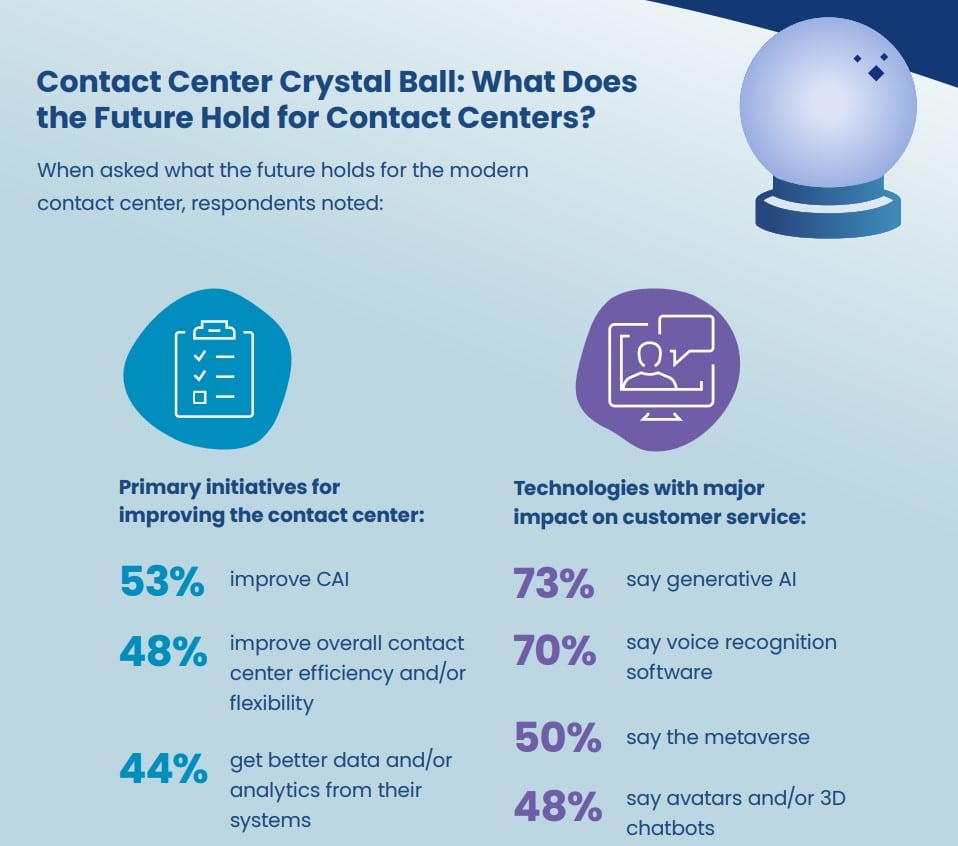When AI appeared like a knight in shining armor to streamline customer service experiences, CX leaders embraced the tech eagerly, rushing to deploy it across contact center channels and solve all their customer interaction woes. That clearly hasn’t happened, but those leaders apparently aren’t seeing the shortfalls in their chatbots, according to new research from customer engagement solutions firm Waterfield Tech—and it may be fatally damaging any hopes they had of building their customer loyalty.
The firm’s new report, Rush to AI Adoption in Contact Centers Generates Contrasting Reactions from Businesses and Customers, based on a survey fielded by Regina Corso Consulting, spotlights this gaping disconnect between CX leaders and consumers over satisfaction with current contact center technologies. According to the survey of more than 200 CX leaders, nearly 80 percent report being very satisfied with their contact center and supporting AI solutions. However, the firm’s earlier May 2023 survey of consumers revealed that only 36 percent are fully satisfied with the different contact center technologies that support their customer service interactions.

The new survey of CX leaders found this disconnect exists even within the businesses themselves when it comes to sentiment around AI and cloud-based systems in the contact center. While senior executives were very satisfied with their contact center technologies overall, the closer the respondents were to managing the contact centers, the more likely they were to identify shortcomings in their solutions. For example, 77 percent of C-suite executives report overall high levels of satisfaction with their AI contact center technologies—but only 65 percent of those in the trenches (e.g., vice president and director levels) expressed satisfaction with their solutions.
AI adoption is increasing—but at what cost?
Waterfield Tech’s 2022 survey of CX leaders showed only 56 percent of respondents were either developing an AI strategy or beginning to deploy AI in contact centers. Now, more than two-thirds (67 percent) of CX leaders report having conversational AI (CAI) or generative AI solutions halfway or fully implemented, while only 30 percent are in the early stages.
This rapid increase could be leading to issues. For example, among the 2,000 consumers surveyed in May, 83 percent worry AI-powered chatbots don’t always understand what they mean, 43 percent say they feel annoyed when they interact with a chatbot, and 50 percent feel AI doesn’t improve the customer experience. However, consumers do see the benefit of AI, with 60 percent believing it can help reduce the amount of time they need to spend interacting with customer service agents to solve a problem.

“With the advances made in the past year, simple and powerful APIs are now readily available and the adoption and deployment of LLM-powered AI in and around the contact center is increasing fast,” said Michael Fisher, chief product officer at Waterfield Tech, in a news release. “But organizations need to understand the ease of initial adoption can mask the difficulty of getting to the finish line. There is a last mile problem in getting LLM-powered AI production ready. Successful implementations require a customer-centric and data-driven approach that combines the right technology, design, and AI training to help organizations actually meet their business goals, their compliance and security needs—and their customers’ expectations.”
Additional findings:
Those closer to the contact center see the shortcomings
- 40 percent of directors/VPs reported their Contact Center as a Service (CCaaS) solutions are not meeting all their expectations.
- Those in the C-suite are more likely than directors/VPs to say their tech solutions across the contact center “definitely” are integrated (66 percent vs. 45 percent) while directors/VPs are more likely to say they only “probably” are (52 percent vs. 32 percent).
- Those in the C-suite are more likely than directors/VPs to say their employee experience strategy supports their CX strategy as one cannot exist without the other (34 percent vs. 16 percent) while directors/VPs are more likely to say it somewhat supports it, but the two strategies are not as integrated as they should be (20 percent vs. 6 percent).
State of the contact center in the cloud
- 60 percent of CX leaders surveyed report their contact center as being cloud-based.
- Of the 40 percent not already in the cloud, 30 percent of respondents expect to migrate their contact center in 2024.
- Among those who are not all or almost all cloud-based, data security concerns was the primary reason, with 29 percent of survey respondents citing security as the primary reason they haven’t fully migrated, followed by concerns of high costs (18 percent).
Industry deep dive
- Those in Consumer Packaged Goods (CPG) are more likely than those in Banking/Finance/Insurance, Retail/e-tail and Manufacturing to say they are very satisfied with their current contact center solutions (91 percent vs. 67 percent, 72 percent and 75 percent, respectively).
- When asked about their level of satisfaction with their contact center AI solutions, opinions varied. Respondents from the CPG and Manufacturing industries were most satisfied, with 78.1 percent and 71.4 percent saying they were “very” satisfied, vs. only 59 percent of those in Banking and 58.3 percent of those in Retail/e-tail.
- When asked what best describes their goals for AI customer service initiatives in the coming 12 months, CX leaders in Manufacturing, Retail/e-tail and CPG reported “deploying customer facing AI” (64.3 percent, 61.1 percent, 59.4 percent) as their primary goal. The top stated goal for those in the Banking sector was “Generating ROI on AI” initiatives (59 percent).
Contact center crystal ball: What does the future hold?
- Over half of respondents (53 percent) say their primary initiative for improving their contact center is to improve CAI while 48 percent say it is to improve overall contact center efficiency and/or flexibility. Over two in five (44 percent) say their primary initiative is to get better data and/or analytics from their systems.
- Almost three-quarters (73 percent) say they see generative AI having a major impact on customer service in the future while 70 percent say voice recognition software will. Fifty percent say the metaverse will, and 48 percent say avatars and/or 3D chatbots will have a major impact on customer service in the future.

Download the survey graphic here.
This online survey was fielded in October 2023. The survey collected responses from 203 senior leaders in customer service at companies with at least 100 employees.







